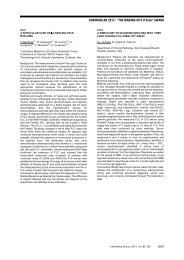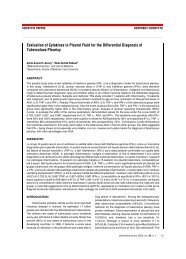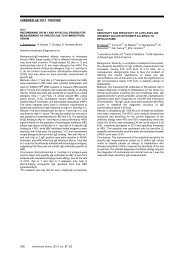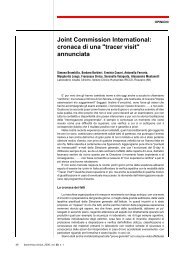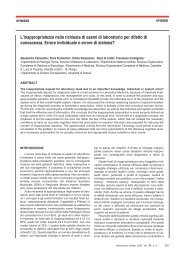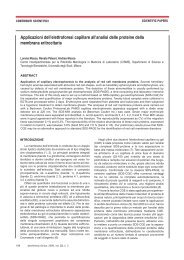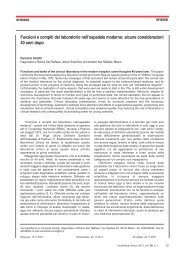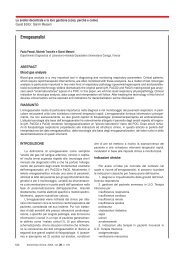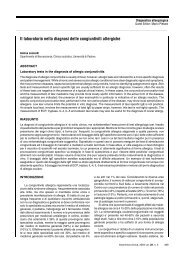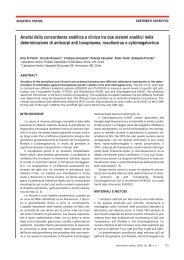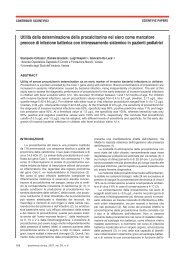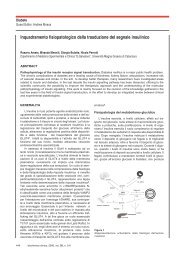Field evaluation of the GeneXpert system for detection of ... - SIBioC
Field evaluation of the GeneXpert system for detection of ... - SIBioC
Field evaluation of the GeneXpert system for detection of ... - SIBioC
Create successful ePaper yourself
Turn your PDF publications into a flip-book with our unique Google optimized e-Paper software.
SCIENTIFIC PAPERS CONTRIBUTI SCIENTIFICI<br />
prothrombin concentrations and an increased risk <strong>of</strong><br />
venous thrombosis. Diagnosis <strong>of</strong> GPro mutation is made<br />
through specific genetic testing, which can also reveal<br />
whe<strong>the</strong>r <strong>the</strong> patient is heterozygous or homozygous <strong>for</strong><br />
<strong>the</strong> condition. Although prothrombin levels are usually<br />
moderately elevated in subjects with this mutation, <strong>the</strong>se<br />
results are not clinically useful in identifying <strong>the</strong> mutation<br />
(7, 8).<br />
In this study, we evaluated <strong>the</strong> <strong>GeneXpert</strong> <strong>system</strong> <strong>for</strong><br />
combined <strong>detection</strong> <strong>of</strong> FVL and GPro in comparison with<br />
<strong>the</strong> Roche Light Cycler assay, routinely used in our<br />
laboratory.<br />
MATERIALS AND METHODS<br />
Study design<br />
This study was per<strong>for</strong>med in a little clinical laboratory<br />
(about 1,500,000 tests/year) located in a non teaching<br />
300-bed general hospital. Between March and August<br />
2011, 211 consecutive patients, referred to our<br />
laboratory <strong>for</strong> evaluating thrombophilia risk factors, were<br />
studied. These patients were evaluated in duplicate <strong>for</strong><br />
FVL and GPro by using <strong>GeneXpert</strong> and Roche Light<br />
Cycler assays. After approval by <strong>the</strong> local Ethic<br />
Committee, this study was carried out according to <strong>the</strong><br />
principles <strong>of</strong> <strong>the</strong> Helsinki declaration; in<strong>for</strong>med consent<br />
was obtained from all subjects.<br />
For <strong>the</strong> study, blood samples were collected into<br />
vacuum tubes (Becton Dickinson) containing 0.129 M<br />
trisodium citrate and stored at +4 °C up to 6 h, be<strong>for</strong>e<br />
test execution.<br />
Methods<br />
Roche Light Cycler assay<br />
DNA samples were isolated from whole blood with<br />
<strong>the</strong> aid <strong>of</strong> a MagNa Pure LC DNA Isolation kit I, using a<br />
MagNA Pure LC automated DNA isolation instrument<br />
(Roche Molecular Biochemicals). DNA samples were<br />
stored at -20 °C until <strong>the</strong> mutations were investigated.<br />
FVL and GPro mutations were detected with <strong>the</strong> Light<br />
Cycler-Factor V Leiden and Light Cycler-Prothrombin<br />
20210GA mutation <strong>detection</strong> kits (Roche Molecular<br />
Biochemicals), respectively. All mutation-related gene<br />
regions were amplified in 20 µL polymerase chain<br />
reaction (PCR) capillary tubes. After preparation <strong>of</strong> <strong>the</strong><br />
master mixture, 18 µL <strong>of</strong> <strong>the</strong> reaction mixture and 2 µL<br />
(approximately 40 ng) <strong>of</strong> genomic DNA or control<br />
template were added to each Light Cycler capillary tube.<br />
For negative control, PCR grade water was added<br />
instead <strong>of</strong> template. The capillary tubes were sealed and<br />
briefly centrifuged in a microcentrifuge and <strong>the</strong>n placed<br />
into <strong>the</strong> Light Cycler carousel. The PCR products were<br />
detected using 3'-fluorescein (FLU)-labelled and 5'-Red<br />
640-labelled probes. When both probes hybridize in<br />
close proximity, fluorescence resonance energy transfer<br />
(FRET) occurs, producing a specific fluorescence<br />
emission <strong>of</strong> Light Cycler-Red as a result <strong>of</strong> FLU<br />
excitation. The fluorescence intensity depends on <strong>the</strong><br />
amount <strong>of</strong> specific PCR products. Amplification per cycle<br />
can be monitored with <strong>the</strong> Light Cycler instrument. At <strong>the</strong><br />
end <strong>of</strong> <strong>the</strong> amplification process, <strong>the</strong> Light Cycler<br />
instrument increases <strong>the</strong> temperature and <strong>the</strong><br />
fluorescence obtained is plotted against <strong>the</strong> temperature.<br />
The mutations are <strong>the</strong>n identified by <strong>the</strong>ir characteristic<br />
curves. Total assay time is approximately 40 min (9, 10).<br />
<strong>GeneXpert</strong> HemosIL Factor II and Factor V assay<br />
The <strong>GeneXpert</strong> is a s<strong>of</strong>tware-driven cartridge<br />
processor with an integrated <strong>the</strong>rmal cycler with a<br />
fluorescence-based <strong>detection</strong> <strong>system</strong> that adopt singleuse<br />
disposable cartridges to obtain nucleic acid isolation<br />
from whole blood and per<strong>for</strong>m a quantitative PCR.<br />
<strong>GeneXpert</strong> cartridge consists <strong>of</strong> multiple chambers <strong>for</strong><br />
complete automation <strong>of</strong> nucleic acid extraction from<br />
whole blood, PCR reaction, products revelation and<br />
quantification. Cartridges contain chambers <strong>for</strong> sample<br />
introduction, lysis buffer, purification and elution buffers<br />
and all real-time PCR reagents and enzymes in two<br />
freeze-dried beads: bead 1 <strong>for</strong> polymerase and<br />
nucleotides, bead 2 <strong>for</strong> primers and probes. Moreover,<br />
all sample-processing wastes are retained within <strong>the</strong><br />
cartridge. The cartridge also has an attached PCR tube<br />
with fluidic connections to <strong>the</strong> reagents in <strong>the</strong> cartridge<br />
chambers; after introduction into <strong>the</strong> analyzer, this PCR<br />
tube is surrounded by heating/cooling plates and by<br />
optical blocks that enable amplification and real-time,<br />
fluorescence-based PCR product <strong>detection</strong>. At <strong>the</strong><br />
center <strong>of</strong> <strong>the</strong> cartridge is a syringe barrel that has a dry<br />
interface (to minimize potential <strong>for</strong> contamination) with<br />
<strong>the</strong> <strong>GeneXpert</strong> device through a syringe plunger, <strong>the</strong>reby<br />
allowing <strong>the</strong> movement <strong>of</strong> fluids within <strong>the</strong> cartridge and<br />
between <strong>the</strong> PCR tube and <strong>the</strong> cartridge (11, 12). Fluid<br />
movement within <strong>the</strong> cartridge is controlled by a rotary<br />
valve. The valve body contains a cavity in which nucleic<br />
acid purification beads are located. Within <strong>the</strong> cavity<br />
<strong>the</strong>re are inlet and outlet ports that provide <strong>for</strong> fluid<br />
movement over <strong>the</strong> purification beads. These beads are<br />
retained within <strong>the</strong> cavity by screens that cover <strong>the</strong> two<br />
ports on <strong>the</strong> back <strong>of</strong> <strong>the</strong> valve body and a flat cap on <strong>the</strong><br />
front <strong>of</strong> <strong>the</strong> valve body. For nucleic acid capture, a whole<br />
blood lysate solution from one reagent chamber is<br />
flowed through <strong>the</strong> beads within <strong>the</strong> valve body (13, 14).<br />
The bound nucleic acid is <strong>the</strong>n washed, eluted, mixed<br />
with PCR reagents, and dispensed into <strong>the</strong> PCR tube <strong>for</strong><br />
amplification and real-time <strong>detection</strong> by scorpion<br />
technique. Scorpion primers are bi-functional molecules<br />
in which a primer is covalently linked to <strong>the</strong> probe. The<br />
molecules also contain a fluorophore and a quencher. In<br />
<strong>the</strong> absence <strong>of</strong> <strong>the</strong> target, <strong>the</strong> quencher nearly absorbs<br />
<strong>the</strong> fluorescence emitted by <strong>the</strong> fluorophore. During <strong>the</strong><br />
scorpion PCR reaction, in <strong>the</strong> presence <strong>of</strong> <strong>the</strong> target, <strong>the</strong><br />
fluorophore and <strong>the</strong> quencher separate, which leads to<br />
an increase in <strong>the</strong> fluorescence emitted. The<br />
fluorescence can be detected and measured in <strong>the</strong><br />
reaction tube (15-17). Examples <strong>of</strong> revelation curves<br />
obtained are reported in Figure 1.<br />
biochimica clinica, 2012, vol. 36, n. 1 21



